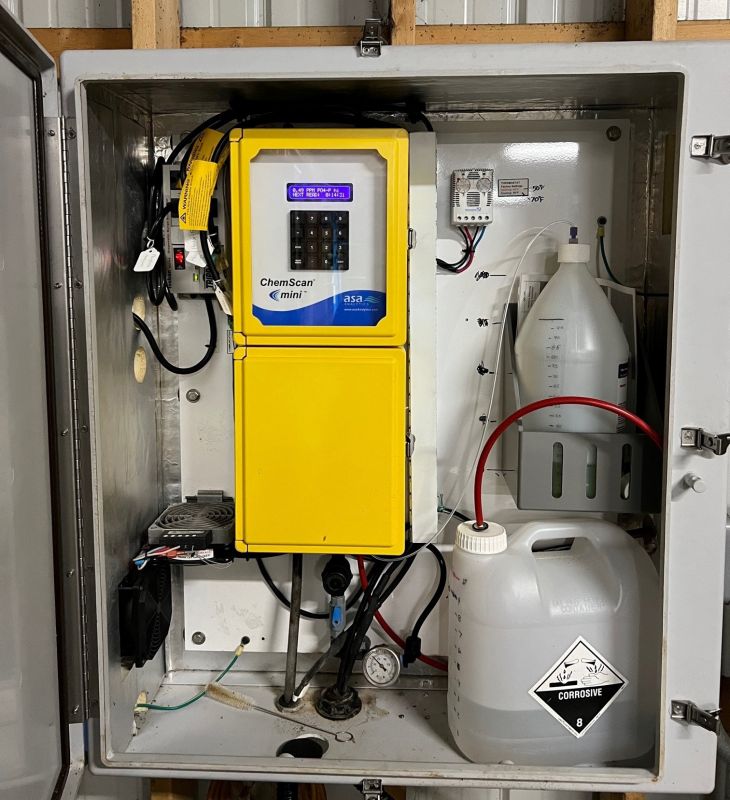Phosphate Monitoring at Effluent Keeps Costs Down and Levels In Check
Published on by Marcus Miller, Digital Marketing Manager at In-Situ in Case Studies
Overview
After studies indicated a need for additional phosphorous treatment, this plant placed a colorimetric water analyzer at the point of effluent to inform chemical dosing.
Challenge
The wastewater treatment plant for the City of Madison, IN, averages about two million gallons per day and oversees about 50 lift stations, for a population of approximately 16,000. A staff of 12 handles plant operations and laboratory analysis of daily grab and composite samples, monitoring BOD, ammonia, phosphorous, TSS and other parameters.
Beginning in 2016, with a new phosphorous limit of 1.0 parts per million pending, staff looked at the plant’s treatment processes and determined that biological reduction alone wasn’t going to be enough to meet that limit. Studies indicated that even if they added tanks to support further biological reduction, they’d still need a chemical on hand to address spikes in ammonia during decanting.
Solution
In 2019, with an abundance of data and a plan, the plant was prepared to identify the most efficient and cost-effective way to add a chemical-feed program to its process.
“We had good data to work with,” says Wastewater Utilities Superintendent Jay Thompson. “In addition to the sample analysis we do five days a week in the lab, we have real-time data collection with DO meters measuring residual oxygen in aeration and dictating amount of air supplied to the basin from our blowers.
“We also look at ammonia and phosphorous levels off the digestors when we decant those, solids concentration in the activated sludge system, and we do some sludge monitoring, given that our biosolids are applied on agricultural land.”
Thompson says they considered going with a flow-based feed that would automatically deliver a chemical dose commensurate with the amount of water coming into the plant. But frequent rain events could potentially lead to overdosing, which would waste money.
“With precipitation, we get inflow and infiltration, but as flows increase that doesn’t mean phosphorous concentrations increase,” says Thompson. “In fact, typically they’re diluted. So, if you use a flow-based system, you’re going to waste chemical.”
Instead, Thompson and his team opted for a ChemScan mini oP Analyzer at the point of effluent.
“The analyzer looks at phosphorous levels leaving the plant in 15-minute increments, and dictates the chemical feed,” Thompson says. With a limit 1.0 and a target of .85., should we see our effluent level go to, say, .9 milligrams per liter, then the analyzer is reading that and talking back to the PLC that controls the feed pump for the chemical, which will adjust accordingly.
“Likewise, if it drops to .4 or .3 due to a rain event diluting influent and effluents, it will tell the pump it can back off chemical feed.”
Thompson says the scalability has several advantages. Obviously, matching chemical use to chemical need reduces cost, but there’s also the issue of sludge production. The plant uses polyaluminum chloride to precipitate influent phosphorous, which, like similar chemicals, binds to the phosphorous and sinks to the bottom of the clarifier, adding to the sludge. The more sludge produced, the higher the cost to stage, store, haul and apply it, says Thompson.
Results
It’s been more than three years since the mini oP was installed, and...
READ MORE
Taxonomy
- Waste Water Technology
- Wastewater Disposal
- Wastewater Use
- Effluent
- Reclaimed Wastewater
- Wastewater Phycoremediation
- Industrial Wastewater Treatment
- Decentralized Wastewater
- Cooling Boiler & Wastewater
- Waste Water Treatments
- Wastewater Treatment
- Wastewater Collection
- Solid Wastes & Wastewater Recycling
- Waste Water Reclaimation
- Wastewater Treatment Plant Design
- Waste Water Serviceability
- Water & Wastewater
- Water & Wastewater
- Waste, wastewater, air, chemical engineering
- Water & Wastewater Treatment
- Water & Wastewater
- Water & Wastewater Operations
- Waste Water Treatment
- Effluent Water
- Water & Wastewater
- Water and Wastewater Manager
- Wastewater Treatment Chemicals and Consulting
- Lead Generation Service for Municipal Water/Wastewater Bids
- water, wastewater, reclaimed water, water resources planning
- wastewater
- Wastewater engineering
- Wastewater Heat Recovery
- Wastewater Treatment Market
- Phosphorus Recovery
- waste water bacteria
- Environmental Impact Assessment (EIA) for Wastewater
- Associate Professor in Water Chemistry and wastewater treatment
- Wastewater operation and management
- On-site wastewater
- Waste water treatment plant operator
- Water and Wastewater Design engineer
- Wastewater Pumps
- Water, Waste Water Chemical & Treatment
- water and waste water process instrumentation and solutions
- Water and wastewater treatment
- Wastewater Reuse Project Finance
- Biological Wastewater Treatment Market
